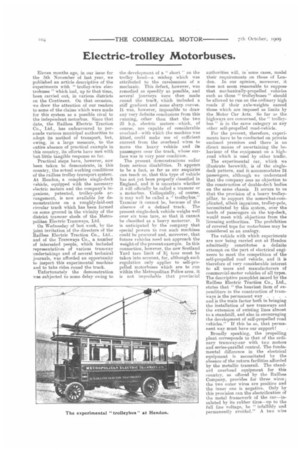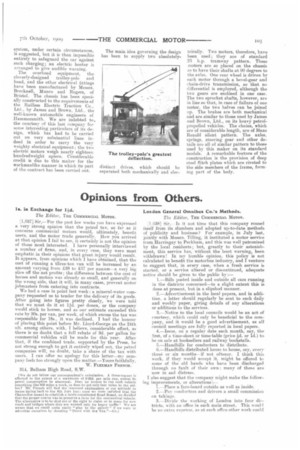Electric-trolley Motorbuses.
Page 16

Page 17

If you've noticed an error in this article please click here to report it so we can fix it.
Eleven months ago, in our issue for the 5th November of last year, we published an article descriptive of the experiments with " trolley-wire electrobuses " which had, up to that time, been carried out, in various districts on the Continent. On that occasion, we drew the attention of our readers to some of the claims which were made for this system RS a possible rival to the independent motorbus. Since that date, the RaiHess Electric Traction Co., Ltd., has endeavoured to persuade various municipal authorities to adopt its method of transport, but, owing, in a large measure, to the entire absence of practical example in this country, its efforts have met with but little tangible response so far.
Practical steps have, however, now been taken to demonstrate, in this country, the actual working conditions of the railless trolley-transport system. At Hendon, a complete single-deck vehicle, equipped with the necessary electric motors and the company's ingenious, patented, trolley-pole arrangement, is now available for demonstrations on a roughly-laid-out circular track which has been formed on some ground in the vicinity of the district tramcar sheds of the Metropolitan Electric Tramways, Ltd. On Wednesday of last week, by the joint invitation of the directors of the Railless Electric Traction Co., Ltd., and of the Tramways Co., a number of interested people, which included representatives of various tramway undertakings and of several technical journals, was afforded an opportunity to inspect this experimental machine and to take rides round the track.
Unfortunately the demonstration was subjected to some delay owing to the development of a " short `• on the trolley head—a mishap which was attributed to the carelessness of a mechanic. This defect, however, was remedied as speedily as possible, and several journeys were then made round the track, which included a stiff gradient and some sharp curves. It was, however, impossible to draw any very definite conclusions from this running, other than that the two 25 lep. electric motors--which, of course, are capable of considerable overload—with which the machine was fitted, could make use of sufficient current from the overhead wires to move the heavy vehicle and its passengers over the track, whose surface was in very poor condition.
The present demonstrations suffer from serious disabilities. It appears to be a fact, so far as our enquiries can teach us, that this type of vehicle has not yet been properly classified in England, and it is uncertain whether it will officially be called a tramcar or a motorbus. Colloquially, of course, it may well be called a " trolkeybus." Tramcar it cannot be, because of the absence of a defined track. The present single-deck vehicle weighs well over six tons tare, so that it cannot be classified as a heavy motorcar. It is anticipated by the company that special powers to rim such machines could be procured and, moreover, that future vehicles need not approach the weight of the present example. In this connection, however, the new Scotland Yard tare limit of 31 tons must be taken into account, for, although such regulation only applies to sell-propelled motorbuses which are to run within the Metropolitan Police area. it is not improbable that provincial
authorities will, in some eases, model their requirements on those of London. In our opinion, moreover, it does not seem reasonable to suppose that mechanically-propelled vehicles such as these " trolleybuses " should be allowed to run on the ordinary high roads if their axle-weights exceed those which are imposed as limits by the Motor Car Acts. So far as the highways are concerned, the " trolleybus " is in the same category as any other self-propelled road-vehicle.
For the present, therefore, experiments have to be conducted on private enclosed premises and there is no direct means of ascertaining the behaviour of the equipment on a highroad which is used by other traffic.
The experimental car, which we illustrate herewith, is of the singledeck pattern, And it accommodates 24 passengers, although we understand that the company sees no objection to the construction of double-deck bodies on the same chassis. It occurs to us that the provision of a heavy trolleypillar, to support the somewhat-complicated, albeit ingenious, trolley-pole, necessitated by this system, over the heads of passengers on the top-deck, would meet with objections from the licensing authorities. The prohibition of covered tops for motorbuses may be considered as an analogy.
The vehicle with which experiments are now being carried out at Hendon admittedly constitutes a definite attempt on the part of electrical engineers to meet the competition of the self-propelled road vehicle, and it is therefore of very considerable interest to all users and manufacturers of commercial-motor vehicles of all types. The descriptive pamphlet issued by the Railless Electric Traction Co., Ltd., states that "the heaviest item of expenditure in the construction of tramways is the permanent way . . . . and is the main factor both in bringing the installation of new tramways and the extension of existing lines almost to a standstill, and also in encouraging the development of self-propelled road vehicles." If this be so, that permanent way must have our support!
Broadly speaking, the propelling plant corresponds to that of the ordinary tramway-car with two motors and series-parallel control. The fundamental difference in the electrical equipment is necessitated by the absence of the return facilities afforded by the metallic tramrail. The standard overhead equipment for this country, as offered by the Railless Company, provides for three wires; the two outer wires are positive and the inner one is negative. Only by this provision can the electrification of the metal framework of the car—insulated by its rubber tires—up to the full line *voltage, be " infallibly and permanently avoided." A two wire
system, under certain circumstances, is suggested, but it is then impossible entirely to safeguard the car against such charging; an electric hooter is arranged to give audible warning. The overhead equipment, the cleverly-designed trolley-pole and head, and the other electrical fittings have been manufactured by Messrs. Brecknell, Munro and Rogers, of Bristol. The chassis has been specially constructed to the requirements of the ltailless Electric Traction Co., Ltd.. by James and Brown, Ltd.. the well-known automobile engineers of Hammersmith. We are indebted to, the courtesy of this last company for some interesting particulars of its design, which has had to be carried out on very substantial lines indeed in order to carry the very weighty electrical equipment ; the two electric motors weigh nearly eighteen hundredweight apiece. Considerable credit is due to this maker for the workmanlike manner in which its part of the contract has been carried out. The main idea governing the design has been to supply two absolutely distinct drives, which should be separated both mechanically and dee trically. Two motors, therefore, have been used ; they are of standard 25 h.p. tramway pattern. These motors are so placed on the chassis as to have their shafts at 90 degrees to the axles. One rear wheel is driven by each motor through a bevel-gear and ehain-drive transmission, so that no differential is employed, although the two gears are enclosed in one case. The two sprocket shafts, however, are in line so that, in case of failure of one motor, the two halves can be joined up. The brakes are both mechanical and are similar to those used by James and Brown, Ltd., on its heavy petrolpropelled vehicles. The chains, which are of considerable length, are of Hans Renold silent pattern. The axles, springs, steering gear and other details are all of similar pattern to those used by this maker on its standard models. A remarkable feature of the construction is the provision of deep steel flitch plates which are riveted to the side members of the frame, forming part of the body.






















